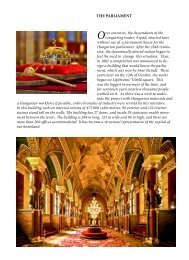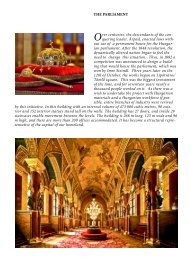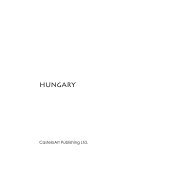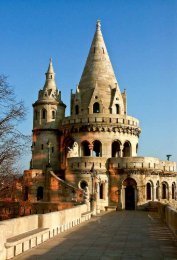You also want an ePaper? Increase the reach of your titles
YUMPU automatically turns print PDFs into web optimized ePapers that Google loves.
MOHÁCS<br />
Mohács, situated on the Danube-bank near Pécs, was one<br />
of the independent settlements of the settler Magyars.<br />
The name of Mohács is interwoven with a sad and<br />
mournful event in Hungarian history: the Hungarians were<br />
defeated on 29 August 1526 in a battle against the Turks<br />
by the armies of Sultan Suleiman near the town, and in<br />
the battle the king was also killed. In commemoration of<br />
his death, a memorial column was erected in 1867 in the<br />
place of the battle. This battle survives in history as the<br />
’Mohács Disaster’. Later, Germans from the Rhineland<br />
and Southern Slavs settled here. Half of the town’s<br />
population is non-Hungarian today. The most spectacular<br />
buildings of the town today bear the marks of Baroque<br />
style. The interesting oriental-Hungarian style Town Hall<br />
building was finished in the early 20th century. Besides<br />
the beautiful buildings, churches, and memorials, visitors<br />
can also witness an operating water-mill. The Busójárás<br />
(’Busó-walking’) organized every spring in the Carnival<br />
season is visited by thousands of people, and is now on<br />
the UNESCO list of Intangible Cultural Heritage.<br />
MOHÁCS<br />
Mohács liegt am Ufer der Donau in der Nähe der Stadt Pécs<br />
und war eine selbständige Ortschaft der landnehmenden<br />
Madjaren. Der Name der Stadt ist mit einem – für die Ungarn<br />
- traurigen Ereignis verbunden, denn hier erlebte Ungarn am<br />
29. August 1526 eine Niederlage in der Schlacht gegen die<br />
Türken durch das Heer von Sultan Süleyman, in der auch<br />
der König starb. Zum Andenken daran wurde 1867 auf<br />
dem Schlachtfeld eine Gedenksäule errichtet. Die Schlacht<br />
ging als die Niederlage von Mohács in die Geschichte ein.<br />
Später wurden hier Deutsche aus dem Rheinland und<br />
Südslawen angesiedelt, die Hälfte der Einwohner der<br />
Stadt sind bis heute keine Madjaren. Die sehenswertesten<br />
Gebäude der Stadt tragen Stilmerkmale des Barock. Das<br />
interessante Rathaus im österreichisch-ungarischen Stil<br />
wurde zu Beginn des 20. Jahrhunderts errichtet. Neben den<br />
schönen Gebäuden, Kirchen, Gedenkstätten ist auch eine<br />
intakte Wassermühle zu besichtigen. Zum Karneval wird in<br />
Mohács der Fastnachtsumzug veranstaltet, der alljährlich<br />
von Tausenden besucht wird und der auch auf die Liste des<br />
geistigen Welterbes der UNESCO gesetzt wurde.












